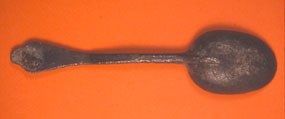
NPS Photo. Historic period archaeological sites, mainly small farmsteads widely spaced and linearly arranged along small, east-west running valleys, exist throughout the outer Cape. The initial European settlement of the outer Cape occurred about 1644 when colonists from Plymouth relocated in Eastham. Historical research tells us that fishing, whaling, trading, and farming all were important for these new inhabitants of the outer Cape. One unique site that can be visited is the Wellfleet Tavern site (also known as Samuel Smith Tavern Site and Great Island Tavern site) on Great Island, part of the headland that now forms an outer boundary of Wellfleet Harbor. The site was excavated in 1969 and 1970 by archeologists Erik Ekholm and James Deetz. Analysis of the artifacts collected by Ekholm and Deetz indicate activity at the site between 1690 and 1740. The artifact types found at the site relate to its designation as a tavern, including high percentages of drinking vessels, pipe stems, and other kinds of glassware. The park's Great Island Trail passes by the Wellfleet Tavern site. Interpretive displays describing and illustrating ancient and historic inhabitants and ways of life on Cape Cod can be found at the National Park Service Salt Pond Visitor Center, at the corner of Route 6 and Nauset Road, Eastham. Francis P. McManamon, National Park Service |
Last updated: October 31, 2017
